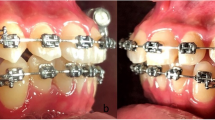Abstract
The investigation comprised 18 consectuvely selected patients, mean age 14.7 years at the start of treatment, with Class II malocclusion, deep overbite and space deficiency in the maxillary arch. The first phase of the treatment consisted of 6 months simultaneous distal movement of maxillary first and second molars with repelling samarium-cobalt magnets on one side and a superelastic nickel-titanium coil on the contralateral side together with an anterior biteplane to achieve bite opening. For the second phase of the treatment, a straight-wire appliance was used for an average treatment time of 1.3 years. Lateral head radiographs and dental casts were available at the start of treatment, after molar distalisation, at the end of treatment and 1 year post-treatment. The treatment resulted mainly in dental changes. The dental Class II molar relation was corrected to Class I by bodily distal movement of maxillary molars and by mesial movement of the mandibular molars. The correction of molar relation was significantly greater on coil sides than on magnet sides, mean 3.4 mm, and 3.0 mm, respectively. Despite anchorage loss associated with the maxillary molar movement, i. e. mesial movement of the maxillary incisors (mean 1.8 mm), the net overjet was reduced, mean 2.5 mm, by the use of Class II elastics. The average net improvement of bite opening was 2.6 mm, mainly due to extrusion of mandibular and maxillary molars. During the 1-year post-treatment period no significant dental or skeletal changes were found. The long-term implications of the treatment results need further consideration.
Zusammenfassung
Es wurden 18 fortlaufend ausgewählte Patienten (bei Behandlungsbeginn durchschnittlich 14,7 Jahre alt) mit dentaler Klasse II, Tiefbiß und Platzmangel im oberen Zahnbogen untersucht. Während der ersten sechsmonatigen Behandlungsphase erfolgte die Distalisierung der ersten und zweiten oberen Molaren mittels sich abstoßender Samarium-Cobalt-Magneten auf der einen und superelastischer Nickel-Titan-Federn auf der kontralateralen Seite bei zur Bißöffnung eingesetzter frontaler Aufbißplatte. Die zweite Behandlungsphase von durchschnittlich 1,3 Jahren wurde mit einer Straightwire-Apparatur durchgeführt. Fernröntgenseitenbilder und Gipsmodelle wurden zu Behandlungsbeginn, nach der Molarendistalisierung, am Ende der aktiven Behandlung und ein Jahr nach Behandlungsabschluß angefertigt. Die Behandlung führte hauptsächlich zu dentalen Veränderungen. Die dentale Klasse II wurde durch körperliche Distalbewegung der oberen und Mesialbewegung der unteren Molaren in eine Klasse I korrigiert. Die Korrektur der Molarenrelation war auf der mit Federn behandelten Seite signifikant größer als auf der mit Magneten behandelten (durchschnittlich 3,4 mm gegenüber 3,0 mm). Trotz des Verankerungsverlustes während der Molarendistalisierung in Form einer Protrusion der oberen Schneidezähne um durchschnittlich 1,8 mm wurde der Netto-Overjet durch Klasse-II-Gummizüge durchschnittlich um 2,5 mm verringert. Die durchschnittliche Bißerhöhung um 2,6 mm war vorwiegend auf die Extrusion der Molaren zurückzuführen. Während der einjährigen Beobachtungszeit nach Abschluß der aktiven Behandlung wurden keine signifikanten dentalen oder skelettalen Veränderungen gefunden. Die Langzeitstabilität der Behandlungsergebnisse bedarf weiterer Untersuchungen.
Similar content being viewed by others
References
Bondemark L, Kurol J. Distalization of maxillary first and second molars simultaneously with repelling magnets. Eur J Orthod 1992; 14:264–72.
Bondemark L, Kurol J, Bernhold M. Repelling magnets versus superelastic nickel-titanium coils in simultaneous distal movement of maxillary first and second molars. Angle Orthod 1994; 64:189–98.
Dahlberg G. Statistical methods for medical and biological students. New York: Interscience, 1940.
Forsberg CM, Hellsing E. The effect of a lingual arch appliance with anterior bite plane in deep overbite correction. Eur J Orthod 1984; 6:107–15.
Gianelly A, Bednar J, Dietz V. Japanese NiTi coils used to move molars distally. Am J Orthod Dentofac Orthop 1991; 99:564–6.
Gianelly A, Vaitas A, Thomas W. The use of magnets to move molars distally. Am J Orthod Dentofac Orthop 1989; 96:161–7.
Hellsing E, Hellsing G, Elasson S. Effect of fixed anterior biteplane therapy—a radiographic study. Am J Orthod Dentofac Orthop 1996; 110:61–8.
Jones R, White M. Class II molar correction with an open-coil jig. J Clin Orthod 1992; 26:661–4.
Miura F, Mogi M, Ohura Y, Karibe M. The superelastic Japanese NiTi alloy wire for use in orthodontics. Part III studies on the Japanese NiTi alloy coil springs. Am J Orthod Dentofac Orthop 1988; 94:89–96.
Pancherz H. The mechanism of Class II correction in Herbst appliance treatment. A cephalometric investigation. Am J Orthod 1982; 82:104–13.
Parker C, Nanda R, Currier F. Skeletal and dental changes associated with the treatment of deep bite malocclusion. Am J Orthod Dentofac Orthop 1995; 107:382–92.
Proffit WR. The second stage of comprehensive treatment: correction of molar relationship and space closure. In: Proffit WR, ed. Contempory orthodontics. St. Louis: Mosby, 1986:419–38.
Steger E, Blechman A. Case reports: molar distalization with static repelling magnets. Part II. Am J Orthod Dentofac Orthop 1995; 108:547–55.
Vardimon A, Graber TM, Drescher D, Bourauel C. Rare earth magnets and impaction. Am J Orthod Dentofac Orthop 1991; 100:494–512.
Author information
Authors and Affiliations
Rights and permissions
About this article
Cite this article
Bondemark, L., Kurol, J. Class II correction with magnets and superelastic coils followed by straight-wire mechanotherapy. J Orofac Orthop/Fortschr Kieferorthop 59, 127–138 (1998). https://doi.org/10.1007/BF01317174
Received:
Accepted:
Issue Date:
DOI: https://doi.org/10.1007/BF01317174




